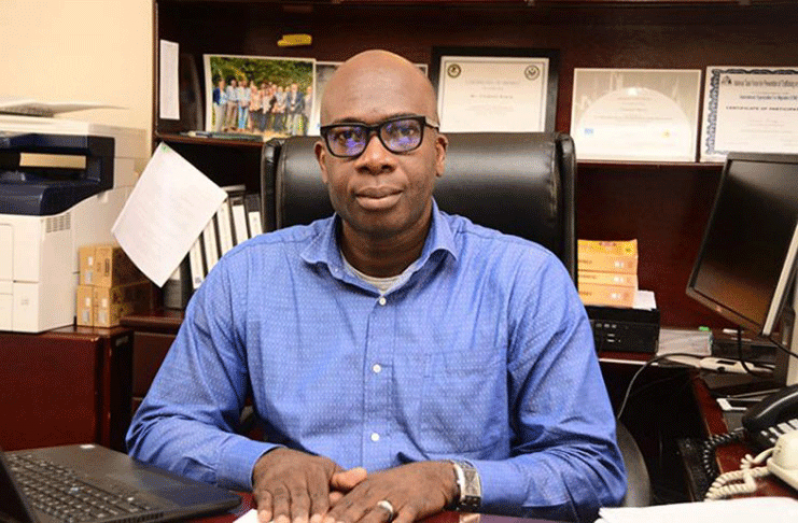– as police force maps crime, optimises use of CCTV cameras
CITIZEN Security Strengthening Programme (CSSP) Project Manager Dr Clement Henry is anticipating a further decline in criminal activities in 2020 as the Guyana Police Force accelerates its crime-mapping programme, while optimising use of the Close Circuit Television (CCTV) cameras to intercept crimes and identify perpetrators.

“It is going to be very, very difficult for anyone to do crime and get away with it in Guyana,” Dr Henry said during a recent interview on the Guyana Chronicle’s online programme – Vantage Point.
According to the Ministry of Public Security, prior to 2015, Guyana had a crime rate of 19.5 per 100,000 persons. Approximately five years after, the crime rate according to the ministry, has dropped to 15 per 100,000 persons.
Dr Henry said the country’s crime rate is expected to drop further in 2020. He explained that the Guyana Police Force, with assistance from the Inter-American Development Bank (IDB) funded Citizen Security Strengthening Programme, is fast-tracking implementation of the crime-mapping initiative. The crime-mapping programme forms part of the National Crime Observatory which utilises the Integrated Crime and Violence Information System (ICIS).
The Integrated Crime Information System provides the Public Security Ministry and the Guyana Police Force (GPF) with access to other existing governmental databases that may possess information that provides complete profiles of perpetrators and victims. The Crime Observatory, in particular, is tasked with conducting spatial statistical analysis and geo-referenced mapping of crime and violence-related injuries and death. The National Crime Observatory was launched since 2010, and though it has been functional, the digital crime- mapping component is now being accelerated. In August 2018, a US$78,750 OR GUY$16M contract was signed for the creation of a digital map of all the crime hotspots in Region Four, (Demerara-Mahaica).

Dr Henry said with the help of Jamaican Consultant Valerie Grant, the Crime Observatory has initiated the process of mapping areas that are prone to criminal activities based on statistical data analysis. He explained that at this stage, the consultant is conducting the mapping exercise as ranks of the Guyana Police Force undergo training for a full take over. The software, which is critical to the process, has already been procured.
“We have just purchased the software and so by the end of this week or early next week, we should have the software available for the Crime Observatory,” the CSSP Programme Manager said.
According to him, by the end of 2019, the Crime Observatory will take full control of the crime- mapping programme, having been trained by the consultant and equipped with the requisite software and equipment to effectively operate.

“The crime-mapping will help us to better understand where the hot spots are, and this would be helpful in crime prevention,” the CSSP Programme Manager said.
In addition to the crime-mapping programme, the police force, with assistance from the Ministry of Public Telecommunications, is also optimising its use of CCTV cameras to prevent, investigate and solve crimes. Last July, the command centre for the CCTV cameras was commissioned at the Arthur Chung Convention Centre, Liliendaal, East Coast Demerara.
“From the cameras, you are able to monitor some of the troublesome spots, but more so it could really improve in terms of police response to crime and I think once all systems are fully in place by early next year, I am thinking that it is going to be very, very difficult for anyone to do crime and get away with it in Guyana,” Dr Henry said.
Iterating that it will soon become very difficult for criminals to engage in illegal acts without being caught, the CSSP Programme Manager said now is a good time for criminal minded people to take the ‘straight and narrow road.’

“I think it is a good time for people who are criminal minded to really…start getting a legal trade, because it is going to be almost difficult to really continue along that path because I think the authorities have been very strategic in implementing strategies to corner criminals and it is really coming to the place where all systems are fully in place. That’s going to make it very difficult for them,” Dr Henry warned.
He posited that these ongoing programmes, some of which focus on intensive training for investigators, are already showing positive results. “In the fight against crime, you are finding that a lot of the crimes are being solved, so the criminals are on the back foot, because crimes are being solved. The police are doing proper investigations and they are quite comfortable now in many of the stations,” Dr Henry pointed out.
Under the CSSP, 10 police stations have undergone massive upgrades and two new police stations were built; one in Linden, Region 10 (Upper Demerara-Upper Berbice), and one at Aurora in Region Two, at a cost of US$1.8M. The police stations at Mibicuri in Region Six (East Berbice-Corentyne); Mabaruma and Port Kaituma in Region One (Barima-Waini); Issano in Region Seven (Cuyuni-Mazaruni); Annai and Aishalton in Region Nine (Upper Takutu-Upper Essequibo); La Grange in Region Three (Essequibo Islands-West Demerara); Cane Grove in Region Four (Demerara-Mahaica); Suddie in Region Two (Pomeroon-Supenaam); and Kwakwani in Region 10 (Upper Demerara-Upper Berbice), were those that underwent rehabilitation.
In 2020, five more police stations will be built while another will be renovated. Dr Henry detailed that the new police stations will be built at Wismar, Linden, in Region 10; at Albion and Whim in Region Six; Baramita in Region One and Mahdia in Region Eight (Potaro-Siparuni), while the Parika Police Station in Region Three will be rehabilitated. The Guyana Forensic Science Laboratory, which is key to police investigations, has been undergoing much-needed renovation and upgrades as well. Last June, the government commissioned a Deoxyribonucleic Acid (DNA)) machine along with a Scanning Electron Microscopy (SEM) machine at the Forensic Lab.
The DNA machine, sourced from Italy, can run eight samples simultaneously and produce results within two hours, thus facilitating an improved investigation rate. Initially, the lab had four departments – toxicology, documents, trace evidence and chemistry, along with six non-analytical departments; security, quality systems, information systems, facilities operations, evidence and administration. However, two new departments – Forensic Video Evidence and DNA testing – have been added.
Last Friday, Minister of Public Security Khemraj Ramjattan at a public meeting at Novar Primary School in Region Five (Mahaica-Berbice) also took note of the drop in crime. He said though the past four and a half years have proven to be challenging, the Guyana Police Force has been continually enhancing the capacity of officers.
“Never before in the history of the Guyana Police Force, have [sic] there been so much training available for members of the force. Ranks have undergone training in places like Mexico, Ecuador, the United Kingdom, as well as in the Caribbean. These programmes have led to better overall performance by the police force with improved skills in catching criminals, and solving crimes,” the Public Security Minister said. He acknowledged the use of technology to fight crime in the country and its increasing success.




.jpg)












